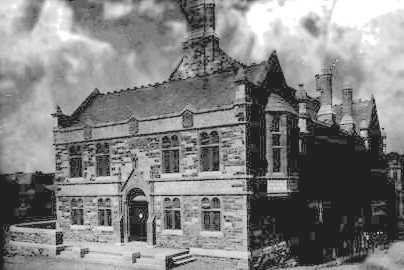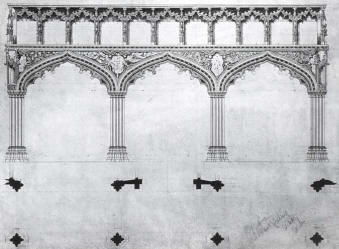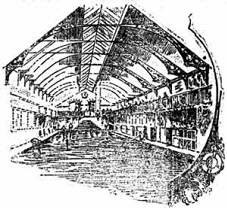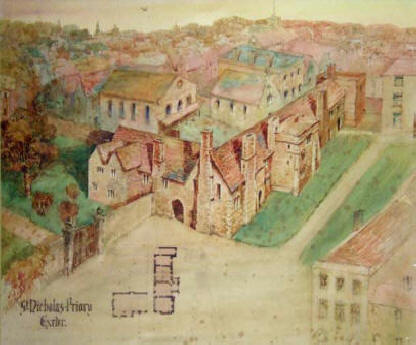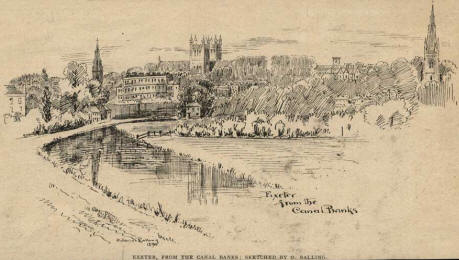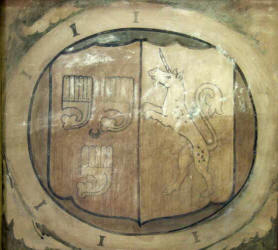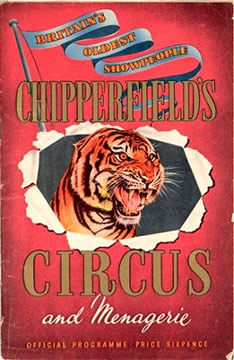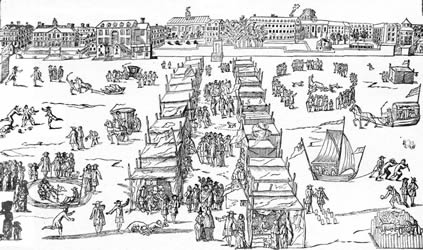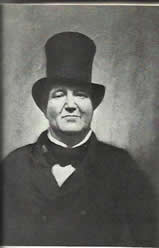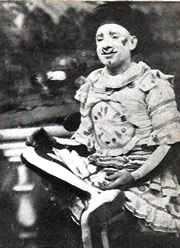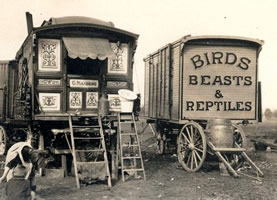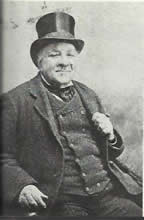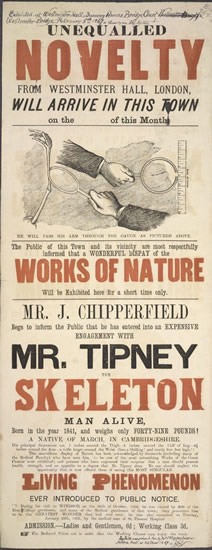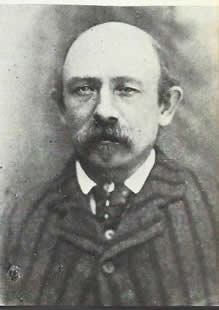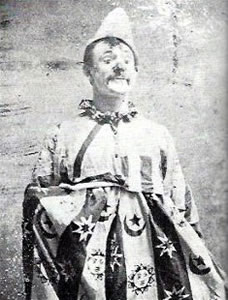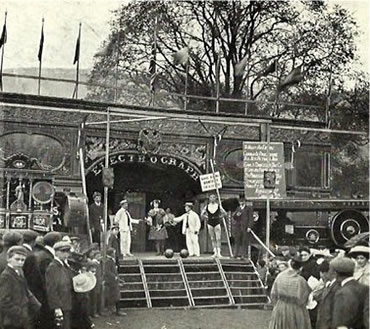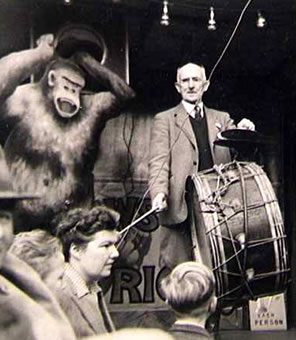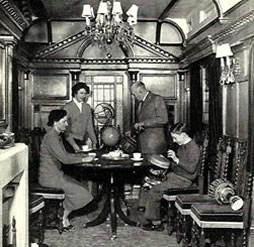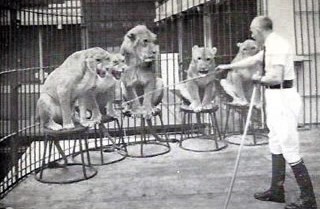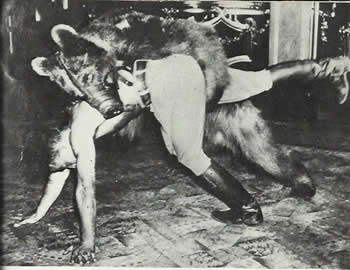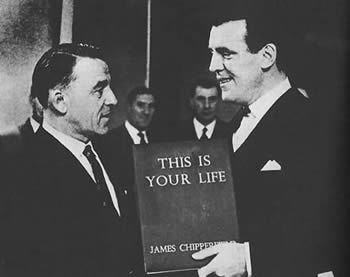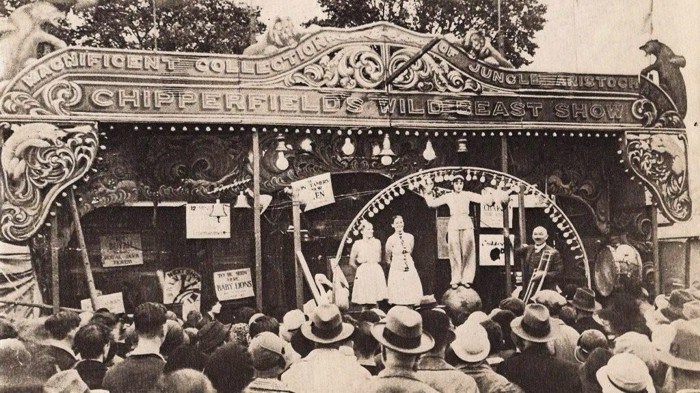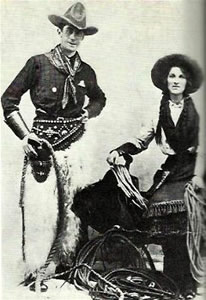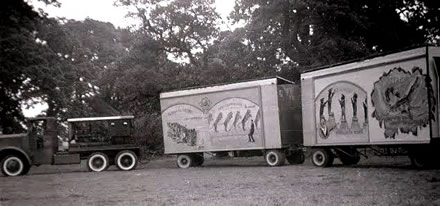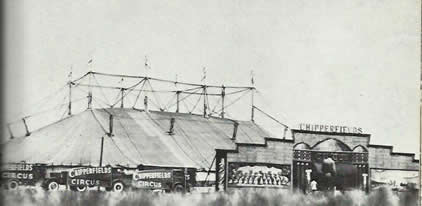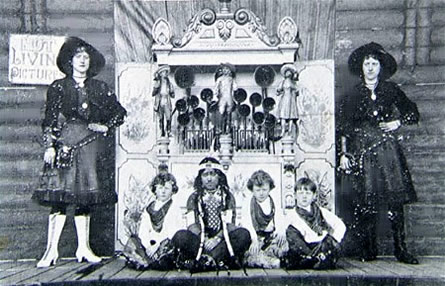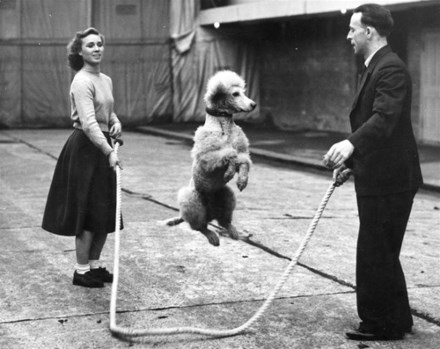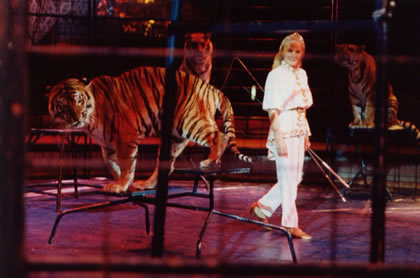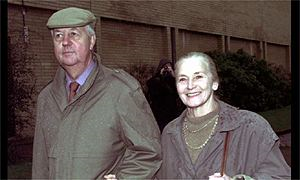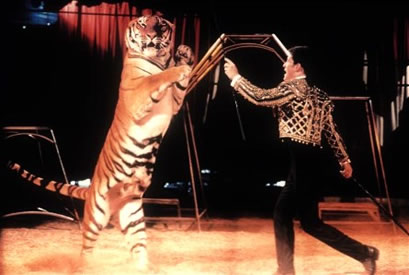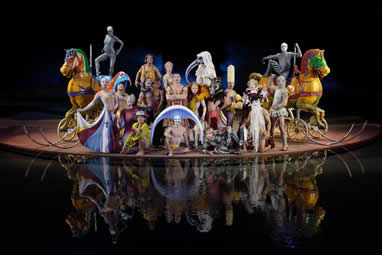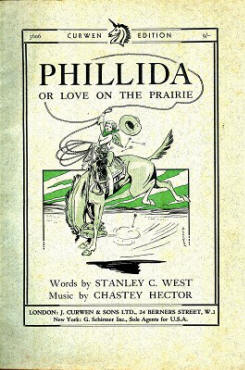
A celebration of those members of our extended family with creative, artistic and performing talents
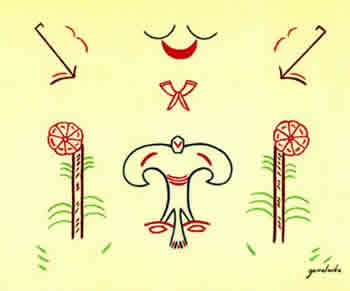
Artistic genes have emerged in the extended family in a number of ways. We have a page dedicated to Arthur Junaluska - actor, director, designer and choreographer. (left: his backdrop for the Rose Moon Dance in his Native American Ballet The Dance of the Twelve Moons.) But there are a number of other artistic talents threaded throughout our extended family - musicians, writers, artists and photographers. The talents of some were well recorded in the family to the advantage of posterity. William Edwards, whose family worked in the cotton mills and iron foundries in Lancashire , took up photography and painting in oils, and did well as a portrait painter. An example of his work and a photo of the painter are in the Heard photo gallery. Others are a mystery - Cousin George Turner 1840-1886, son of a bricklayer, described himself as a teacher of drawing and painting in Chelsea in 1871, and as an Art Master in Kendal in 1881. Walter Hattin, b. 1880, from 4 generations of shoemakers, in 1901 census is found lodging at 5 Beaumont Terrace, Paignton, Devon, described as a "Painter's Artist". Walter's artworks have so far eluded me, but other family members' talents are described here. Arthur Junaluska is not the only family member involved with the performing arts. We have musical talents and circus arts represented.
Charles Causley, the Cornish Poet
Charles Causley is often called the best Poet Laureate we never had. He is regarded today as a Cornish poet, but his paternal line is in fact Devonian. His mother's family carried the Cornish blood, and he was the first Causley in the family to be born in the county. His paternal grandfather was married to one of our Greenslades. Emma Greenslade, born in about 1840 was aunt to Harriet Hatting Pickett,née Greenslade. Emma died just eight years after they were married, having lost two sons. Charles's grandfather, also Charles, then married a Maria Webber who was to be the poet's grandmother.

Charles, son of Charles Causley and Laura Bartlett, was born in Launceston, Cornwall on 24 August 1917. His father never recovered from the effects of his time in the trenches and died in 1924, when Charles was seven. His mother had to do menial work to support them; but there were books in the house and he never felt any sense of deprivation.
He was educated at the local elementary school, and then at Launceston College, for which he gained a scholarship. As a youngster he had enjoyed reading and writing poetry. He began a novel at the age of 9. But it was later in his teens, on a first visit to London, that he bought a copy of Siegfried Sassoon's 1919 War Poems and this led him to Robert Graves, Edmund Blunden and Wilfred Owen.
He had just taken his school certificate when his mother announced that she had got him a good job in a builder’s office and he was obliged to leave school at 15. After that he worked for an electrical company, reading all the while and experimenting with writing. His particular admirations were for Hardy and for D. H. Lawrence. At this time too he played the piano in a dance band. His first play, Runaway , was published when he was 19. His second, The Conquering Hero, in the following year.
In 1939 he joined the Navy. He was a coder in the communications department, and was promoted to ordinary coder and eventually to acting petty officer. His life and experiences in the Royal Navy inspired his career as a poet. He began writing poems about his experiences in 1943, partly as a way of withdrawing from the queasiness of seasickness and fear. His first book of poems, Farewell, Aggie Weston, was published in 1951 by Erica Marx’s Hand and Flower Press. Naval service made a deep impression, and many of his later poems are tales of comradeship, adversity and loss. He also wrote a book of sea stories, Hands to Dance and Skylark, named after an old naval order to ratings to work off their high spirits.
On demobilisation Causley trained as a teacher at Peterborough Training College. On qualifying he returned to Launceston to teach in the school where he had studied as a boy. He discovered a skill as a children’s poet that earned him as much recognition as his other writings. Many of his works were published at least from his publishers perspective with a younger readership in mind, though he might not have entirely agreed with this focus. But the publication of Farewell, Aggie Weston had established his reputation as a poet for all ages, and this reputation remained intact throughout his life.
He was to remain in Launceston for the rest of his life, leaving there only rarely. He never married. Despite his reluctance to leave Cornwall he clearly enjoyed the time he twice spent in Perth, Western Australia as a visiting Fellow at the University of Western Australia, and at the Banff School of Fine Arts in Canada. He wrote with relish about travel in these countries and the United States.
For three years in the mid-1950s he was literary editor of two BBC magazines, Apollo in the West and Signature, and from 1962 to 1966 he was a member of the Arts Council’s poetry panel.
In 1966, his mother suffered a stroke. He chose to nurse her at home for six years until her death. He retired from teaching, a deputy head, in 1976. He published several anthologies of his poetry with updated Collected Poems in 1992, 1997 and 2000. He was much in demand at poetry readings in the United Kingdom. He made many broadcasts and was a regular contributor to BBC Radio Cornwall. He was visiting Fellow in Poetry at Exeter University in 1973/74; in 1977 he was awarded an honorary doctorate from the same university.
Causley received many honours. In 1958, he was made a Fellow of the Royal Society of Literature. He was twice awarded a travelling scholarship by the Society of Authors. He was awarded the Queen's Gold Medal for Poetry in 1967, and a Cholmondeley Award in 1971. He won the Ingersoll/TS Eliot Award, and was presented with the Heywood Hill Literary Prize in 2000. He was appointed CBE in 1986 and, in 2001, elected one of the 10 Companions of Literature by the Royal Society of Literature. Over a period of 50 years, he gained a reputation, not only as a major poet, but also as an editor of poetry collections, as a playwright and as a writer of prose. He also collaborated with composers to produce librettos and the setting of many poems to a musical score.
Charles died on 4 November 2003, aged 86. He is buried in Launceston, next to his mother.
The Marvellous Corrick Family Entertainers
The Marvellous Corrick Family of Entertainers were a household name in Australia and New Zealand in the early 1900s. Indeed they toured the world, and references can be found to their appearances in Asia and in the UK (for example at the Athenaeum in Llanelli).
Albert Corrick was born in Street, Somerset, in 1849, the son of John, a shoemaker, and Eliza Corrick, who both worked for Clarks, the already well-established shoe manufacturer. Albert emigrated to New Zealand on the Mermaid, in 1862. He began a career as a music teacher, church organist, composer and performer. He met and married Sarah, née Calvert, an emigrant from Durham, who taught piano. They opened a music school in Christchurch, and imported sheet music. When the children started to arrive, Albert was determined that they would become musicians, and all were taught instruments. The family started what was to have been a short concert tour during school holidays. It proved so successful that it was extended to all capitals in Australasia; then to the East, and in 1907 to Europe. The line-up comprised "Professor" Albert Corrick (organist, violinist, conductor and teacher), Madam Corrick (contralto, cello), and their children Alice (soprano, piano), Gertrude (piano, cello), Amy (flute, piccolo), Leonard (clarinet and saxophone player, singer of comic songs,and the family projectionist and cinematographer), Ethel (singer, violin), Jessie (singer and violin), Elsie (singer, violin, piano) and Ruby (cornet and French horn). The family were also hand-bell ringers of some note. Alice seems to have been the star, and had already won acclaim with her voice at the age of 17. During a European tour she visited Paris where she received voice coaching under Mme. Machesi.
This extract from a review of their season at the Mechanics Institute that appeared in the Launceston Examiner, 27th May 1902 gives a flavour of their appeal.
"A programme of 16 items was submitted, ...[which] was considerably augmented by encores. The entertainment was not confined exclusively to musical numbers, and occasional variety was afforded by exhibitions of fancy dancing, and the display of a series of interesting biograph pictures. The first number was an overture, "Bohemian Girl" by the company, the instruments consisting of flute, cornet, violins, piano and clarionet. ...The music was of high class quality. Miss Alice Corrick sang the grand scena and aria from "Der Freischutz", and received quite an ovation. For an encore, [she] sang "Soldiers in the Park", and her second number on the programme was "Tell me, my heart". This latter item was well received, and in response to a double encore, Miss Corrick sang "Comin' thro' the Rye" and "The Cows are in the Corn". Madame Corrick, who is possessed of a sympathetic contralto voice, sang "Alone on the Raft" which was illustrated with limelight views... Various selections were played on the hand bells by the company and some excellent music was produced, each item being encored. Miss Ethel Corrick was recalled for her singing of the humorous song "Keep on the Sunny Side" and Professor Corrick sang with good effect "Lads in Navy" which was illustrated with 50 views, descriptive of the words. A clarionet solo, orchestral selections and a number of biograph pictures contributed largely to the success of the entertainment. "
John Boydell, Engraver, Printmaker,Publisher
John Boydell (1719-1804) displayed his artistic genes not only in his own work as an engraver, but in his creative approach to engraving, printselling and public taste that was to change the fortunes and rôles of engraver and publisher beyond recognition.

John Boydell
The son of a Land Surveyor in Dorrington, Shropshire, at the age of twenty John was fascinated by an engraving by W. H. Toms in Baddeley’s Views of Country Seats, which depicted a neighbouring estate. It prompted him to give up his career and go to London, where he managed to apprentice himself to Toms for seven years. Each day he worked about fourteen hours for Toms and then attended drawing classes at night at the St. Martin’s Lane Academy, and taught himself French and perspective. He bought himself out of his apprenticeship with a year to go, and started his own business. Around 1747, Boydell published his first major work, The Bridge Book, for which he drew and cut each print himself. It cost one shilling and contained six landscapes each of which, featured a bridge, not surprisingly.
He persuaded a number shops to sell his book, and met with such success that very soon he could afford larger plates and was able to make engravings, generally of views in or near London, which he could price at one shilling each.
By 1751 he had completed 152 views in England and Wales, which he sold in collections priced at five guineas each. He had also engraved numerous plates after Old Masters, especially Berghem. Though many of his own engravings, and especially his large shipping scenes on the Thames, are attractive works with strength and merit in design and execution, he thought little of them. When he published A Collection of Views in England and Wales, he remarked in his Preface that he had learnt the art too late to arrive at great perfection. Also in 1751, when he became a member of the Stationers' Company, he started buying other artists' plates and publishing them in addition to his own. He started a small printselling business which did well and in 1752 he moved to Cheapside, where he stayed until his death. As both artist and print dealer, if his own works did not sell well, he could supplement his earnings by trading in the prints of other artists.
As a printseller he resented the fact that when purchasing prints of French engravers they thought so little of English work that he had to pay cash, instead of exchanging prints with them. He determined to change this. He hired William Woollett, the foremost engraver in England, to engrave Richard Wilson’s Destruction of the Children of Niobe. Boydell paid him approximately £100 for the Niobe engraving, an extraordinary fee compared with the going rate for such commissions. The print was hugely successful: Boydell actually sold more than £2,000 worth, but more importantly, the French accepted it as payment in kind. In fact, it was the first British print actively desired on the Continent. Urged on by Boydell, Woollett
followed the Niobe with more engravings and in 1776 he had his greatest success when he engraved Benjamin West’s Death of General Wolfe. Though John Boydell held only a third share in the profits from this work until Woollett’s death in 1785, it earned him no less than £15,000 in its first fifteen years.
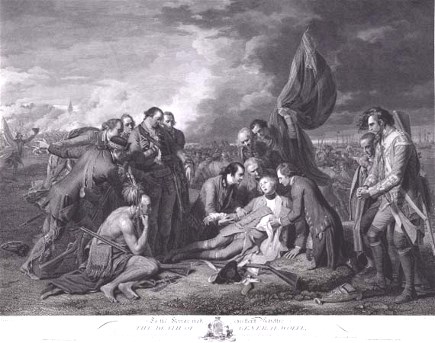
The Death of General Wolfe, engraved by Woollett after the painting by West
His creative instinct was undimmed. In 1786 he conceived his crowning achievement. He announced his Shakespeare project, a massive, indeed grandiose undertaking. He determined to commission two series of Shakespearean oil paintings, one large and one small, from all the principal artists of the day; to build a gallery for their permanent exhibition; to publish, without the text, an Imperial Folio collection of engravings after the larger paintings and to publish a Folio edition of Shakespeare’s Dramatic Works with the highest calibre of typographic excellence, illustrated with engravings from the smaller pictures.
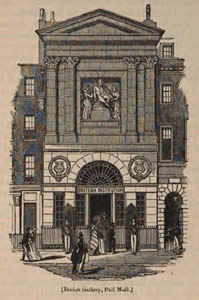
The Shakespeare Gallery in 1851 when it had been
purchased by the British Institution
By the time the Shakespeare project was complete, forty engravers had been employed to reproduce 170 paintings by forty four artists, among whom were Reynolds, Romney, Fuseli, Benjamin West, and Wright of Derby: the Shakespeare Gallery had been built in Pall Mall on the site now occupied by the Marlborough Club: and the Boydells’ total outlay had exceeded £100,000.
Not content with this commitment, and undeterred by the outbreak of the French Revolution, no sooner had the first part of the Dramatic Works been published in 1791 than Boydell announced two other projects, the one for an illustrated Milton in three Folio volumes, which was duly completed in 1797, and the other for An History of the Principal Rivers of Great Britain, with coloured aquatint plates, in five similar volumes. Of this latter only one volume appeared, An History of the River Thames with seventy six aquatints after Farington.
But eventually the Napoleonic wars destroyed Boydell's trade. effectively bankrupt, the great support felt for this man who had been made Lord Mayor of London, and President of the Royal Academy encouraged Parliament to support a lottery with the proceeds of which his business could be saved,and with the Shakespeare gallery as a prize. On his death bed John Boydell learned that the lottery had raised enough to save the business which his nephew Jacob took forward.
According to Bruntjen, "it was due to the enthusiasm of Boydell and others that the English government eventually provided funds for the establishment of the National Gallery in 1824."
My Mother Saw a Dancing Bear
My mother saw a dancing bear
By the schoolyard, a day in June.
The keeper stood with chain and bar
And whistle-pipe, and played a tune.
And bruin lifted up its head
And lifted up its dusty feet,
And all the children laughed to see
It caper in the summer heat.
They watched as for the Queen it died.
They watched it march. They watched it halt.
They heard the keeper as he cried,
“Now, roly-poly!” “Somersault!”
And then, my mother said, there came
The keeper with a begging-cup,
The bear with burning coat of fur,
Shaming the laughter to a stop.
They paid a penny for the dance,
But what they saw was not the show;
Only, in bruin’s aching eyes,
Far-distant forests, and the snow.
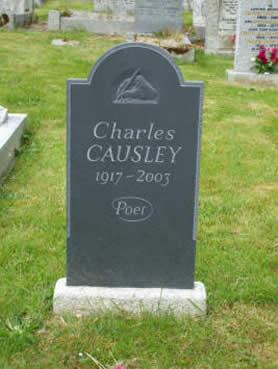
Charles Causley's grave in Launceston,
next to his mother's
By the wild sea-wall I wandered
Blinded by the salting sun,
While the sulky Channel thundered
Like an old Trafalgar gun.
And I watched the gaudy river
Under trees 0f lemon-green,
Coiling like a scarlet bugle
Through the valley of the Teign.
When spring fired her fusilladoes
Salt-spray, sea-spray on the sill,
When the budding scarf of April
Ravelled on the Devon hill.
Then I saw the crystal poet
Leaning on the old sea-rail;
In his breast lay death, the lover,
In his head, the nightingale.
Charles Causley
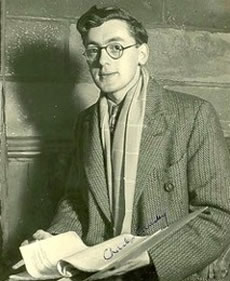
The young poet
![]() Download our family history of Cornish poet Charles Causley
Download our family history of Cornish poet Charles Causley ![]()
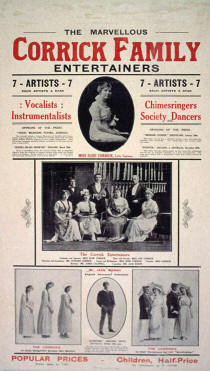
In Australia as well as the cities they would tour the goldfields and the outback to great acclaim. The daughters were famous for their glamorous stage gowns, often embroidered with Indian silver thread, and made in Paris.
After 1900 they began to introduce a biograph show into their act (magic lantern slides) which very soon was supplemented with moving films. Son Leonard took responsibility for this part of the act, and became skilled in film-making, for the Corricks included films they had made themselves, as well as showing commercially acquired short films. In the 1970s the Corrick Collection of over 100 early films, including their own, was presented to the Australian National Film and Sound Archive. For some time, also, the family provided the musical accompaniment to the silent films in the Princess Theatre in Launceston, Tasmania. Albert died in Launceston in 1914. The family settled there after his death and performed occasionally for charity. They last appeared together in 1932. Sarah died in Launceston in 1935. Alice's son was to marry our Crocker descendant, Elsie Jackson.
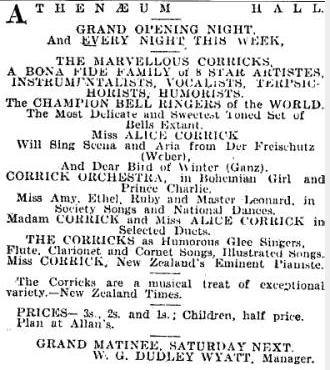
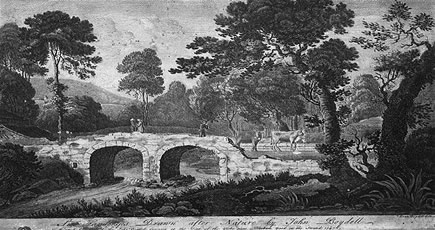
Boydell's engraving of a landscape with bridge from 1747
 A View Taken Near Limehouse Bridge, Looking Down The Thames, by John Boydell
A View Taken Near Limehouse Bridge, Looking Down The Thames, by John Boydell
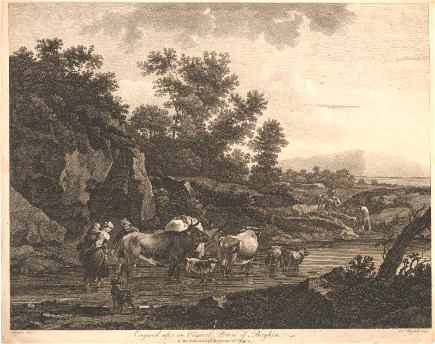 An engraving by Boydell after a painting by Berghem
An engraving by Boydell after a painting by Berghem
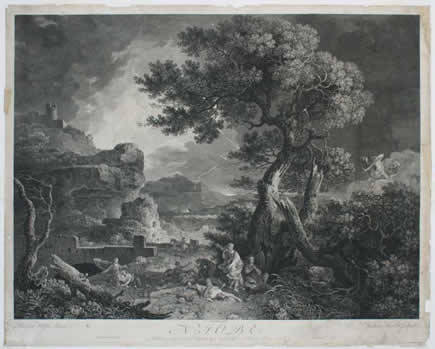
Engraving of Destruction of the Children of Niobe, by William Woollett after Richard Wilson

Detail from A View of Woolwich by John Boydell
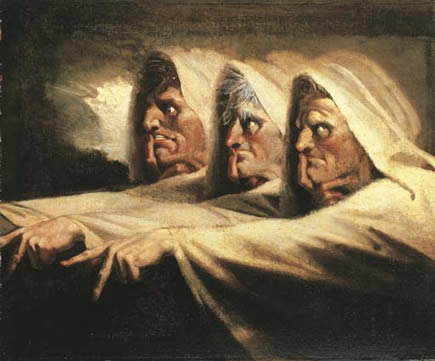
Above - the painting by Henry Fuseli of The Three Witches from Macbeth, and below an engraving by John Raphael Smith after the painting - both works part of John Boydell's Shakespeare project.
The Donalds; Two Generations of Poets
These two very different poems were both written by George Donald, 1800-1851.
CHEETIE PUSSIE
George Donald, about 1840
Published in Songs for the Nursery, in Whistle-Binkie,
pub. Robertson & Co., Glasgow, 1840
(and the source for much of the information on George)
CHEETIE! cheetie pussie!
Slippin’ thro' the housie,
Watchin' frighted mousie—
Makin' little din;
Or by fireside currin',
Sang contented purrin',
Come awa' to Mirren,
Wi’ your velvet skin!
Bonny baudrons ! grup it !
Straik it weel an' clap it!
See the milk, it's lappit,
Ilka drap yestreen;
Hear to hungry cheetie!
Mewlin' for its meatie,
Pussie, what a pity
Ye shou'd want a frien'!
Throw the cat a piecie,
Like a kindly lassie,
Ne'er be proud and saucy,
Hard an' thrawn like Jean;
Doggie wants a share o't,
If ye've ony mair o't,
Just a wee bit spare o't,
An' you're mither's queen!
Cheetie! cheetie pussie !
"Watchin’ frighted mousie,—
Slippin' thro' the housie
Wi your glancin' een;
Or by fireside currin',
Sang contented purrin',
Come awa' to Mirren,
Tell her whare you've been!
Cheetie Pussie Manuscript
SONGS FOR THE PEOPLE No V
George Donald, 1840
Published in The Chartist Circular, January 11th 1840
What is a Chartist – is he one
Whose creed is anarchy and spoil?
Is blood the basis of his plan,
And does he ply the impostor’s guile?
He dares the authors of his ills
From word or action to infer
That these compose his principles-
That this is like his character.
He, with indignant sorrow hears
The prayer of want and wail of woe
Fall heedless on the tyrant’s ears,
And swears that such shall not be so.
Along the city’s crowded streets,
And in the once contented cot,
The willing sons of toil he meets,
Now unemployed, and weeps their lot.
By foul corruption’s lavish waste –
By faction’s lust for power and place,
He sees his land to ruin haste,
And strives to save it from disgrace.
He knows that men are equals born,
But sees the many by the few
Are of their birthright basely shorn,
And holds the robbery up to view.
He says that all should have the choice
Of those for them that legislate;
For well he knows the people’s voice
Their wrongs alone can terminate
He says – and wealth at this may storm-
That there is many a wealthy fool;
And rank and riches should not form
The right of any one to rule.
Oppression in its every guise,
Against the body or the mind,
He hates, and fain would exercise
Good will and peace to all mankind.
This is a Chartist – who will say
His claims are wicked and unjust?
Keep patriot, then, your conquering way,
Till opposition bites the dust.
Soon happiness and liberty
Shall crown the battle you have fought,
And Whig and Tory only be
Remembered by the wrongs they wrought.
Be steadfast in your glorious cause,
Tho’ here and there some victims fall,
Till equal rights and equal laws
Shall be secured to one and all
George Donald, was born in Calton of Glasgow, in 1800. His ancestors were from the Western Highlands. His father was a tenter (mechanic) in one of the power loom factories in Calton. At the age of 8 George worked with his father for 14 hours a day, 6 days a week with an hour and a half for meals. Because he exhibited a passion for reading he was allowed to attend school for two hours a day by the factory manager. This mean education was enough to inspire his writing, and to nurture the independent mind that prompted his radicalism.
There had been rebellion and unrest in Scotland in the late 18th century, and the rumblings of rebellion flared up again in 1820, with a widely supported general strike. At Paisley 300 armed radicals closed the mills. George was inspired by and participated in this radical rebellion. The family believe that George had to leave Scotland for some time as a result of his part in this uprising. There is no evidence of this. But in 1826 the Thornliebank factory closed as a result of the economic depression, and George lost his job. He went to Ireland with the family, where he was employed as a manager, but could not settle and returned to Scotland.
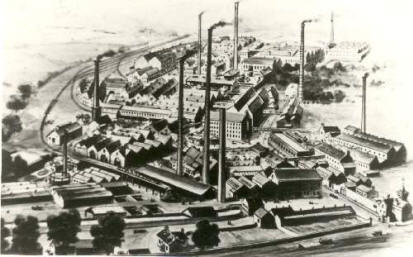
The cotton print works at Thornliebank where the Donald family worked
Finding himself out of work he went to America for a while but soon returned to Scotland. The Chartist Circular wrote of him in 1841,"He is the woeful nursling of a cotton factory - intelligent, morbid, sensitive, long inured to poverty and tossed about this barren world like an isolated wreck on the stormy ocean. Penury and woe are his familiars, yet he is a bard of genius..." For 18 months he was a partner on the short-lived radical newspaper The Liberator, which failed, losing much money. His wife returned to him for brief periods, and George's life continued in and out of work and drink. He published "The Lays of the Covenanters" which won him some critical acclaim but very little money. He wrote "Memoir of a Glasgow Unfortunate" which was serialised in a Glasgow newspaper. At one time he wrote to a benefactor "I am shoeless and shirtless and cannot write for the cold"

My Dragon in Songs for the Nursery
During part of his last days Donald was employed in the office of the Glasgow Examiner. A cold, which he caught in 1850, settled down to his chest. His health never recovered. Despite the ministerings of his family and his doctors he died in December 1851. George's failings had involved his family in long struggles with poverty and its attendant ills.
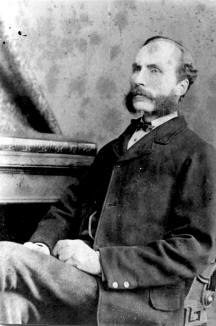
George Donald Junior
George's eldest son, George Donald Jnr. could not forgive the privations that his father's lifestyle had imposed on the family. He was obliged to begin work in the calico printfield at the age of 12 as a calico print colourist apprentice. But he had inherited his father's poetic gift, and whilst working at a succession of jobs he attended the Glasgow School of Arts in the evenings and submitted poems and articles to newspapers and journals. At the evening school he was latterly appointed a monitor- teaching for one hour, and receiving free instruction during the next. Eventually he was to serve for 11 years as a journalist for the Glasgow Examiner. But he was also the proprietor of a Temperance Hotel, and for 23 years the Assistant Inspector and Inspector for the administration of the Poor Law for the Govan Parochial Board. The family story is that this George too became an alcoholic. His last recorded job in the 1891 census was as a clerk. He died in 1893 at the age of 66. George's son married g-g-great aunt Elizabeth Berry's granddaughter.
In the course of his life, as well as poetry, George Donald Jnr published prose sketches, tales, literary reviews, etc., in newspapers, periodicals, and magazines. He taught himself French, and published translations of French verse. In 1865 he published a collection of his work in Poems Reflective, Descriptive and Miscellaneous, including some very personal poems, some Scottish poems, and some of his translations. It received mixed reviews.
The following poems are the work of son George Donald, 1826-1893
Our Ain Green Shaw
They tell me o’ a land where the sky is ever clear,
Where rivers row ower gowden sands, and flowers unfading blaw.
But, O, nae joys o’ Nature to me are half sae dear
As the flowrets bloomin’ wild in our ain green shaw.
They speak o’ gilded palaces, o’lords and leddies fair,
And scenes that charm the weary heart in cities far awa’,
But nane o’ a’ their gaudy shows and pleasures can compare
Wi’ the happiness that dwells in our ain green shaw.
O weel I lo’e when Summer comes wi’ sunny days and glee,
And brings to gladden ilka heart her rural pleasures a’,
When on the thorn the mavis sings, and gowans deck the lea,-
O there’s nae spot then sae bonnie as our ain green shaw.
While heaven supplies my simple wants, and leave me still my cot,
I’ll bear through life a cheerfu’ heart whatever may befa’,
Nor ency ithers’ joys, but aye be canty wi’ my lot
When wanderin’ in the e’en through our ain green shaw.
Edited by Edwards, Brechin 1881
To A—— W-——.
[presumably his wife-to-be Agnes Wilson]
Those eyes with love's pure rapture beaming;
Life's joys are vain apart from thee,
Its fairest shows but empty seeming.
O, with thy radiant beauty bless
This heart, for thee so fondly glowing;
With rapt affection's holy kiss
An ecstacy divine bestowing!
While at thy feet reclined I dream
Of sorrows past, of ills before me,
I a poor exiled wanderer seem,
And thou an angel bending o'er me;
Then the mild lustre of thine eyes,
Thy holy smile, thy voice of gladness,
Come like an influence from the skies,
And banish all my bosom's sadness.
Oh! if condemned to lose thy love,
That with so sweet a spell hath bound me,
No light could cheer me from above,
And Nature would seem dead around me;
Where'er my wandering steps should go,
Remembrance of that love retaining,
Would only bring me deeper woe,
And sadder make my vain complaining.
Light of my soul! O, turn on me
Those eyes with love's pure rapture beaming;
Life's joys are vain apart from thee,
Its fairest shows but empty seeming.
O, with thy radiant beauty bless
This heart, for thee so fondly glowing;
With rapt affection's holy kiss
An ecstacy divine bestowing!
Published in Poems, Reflective, Descriptive and Miscellaneous, by George Donald, pub. Thomas Murray and Son, Glasgow, 1865
George Donald's death announced in the Glasgow Herald, 19 June 1893
Octavius Ralling - Architect 1858-1929
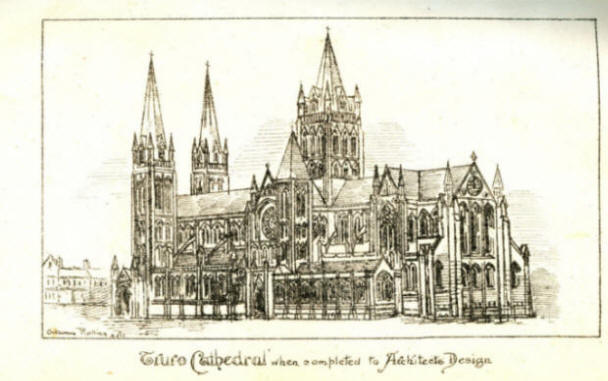 Octavius Ralling indulged an enjoyment of drawing in his personal life as well as his professional. This is a frontispiece to a Church History of Cornwall, published in 1887 |
|||
| In March 1877 it was announced in the Essex Standard, West Suffolk Gazette, and Eastern Counties' Advertiser that student Octavius Ralling had been successful in the Freehand and Model Drawing Night Art Classes of the Colchester Literary Institution. My Uncle Bob's grandfather, I've not been able to discover much about the life of Octavius, or even too much about his professional work. But there are plenty of surviving examples of his draughtsmanship for us to admire the skill that won acclaim for the 19 year-old student - albeit in what was effectively the family newspaper! The eighth son of Thomas Ralling, a journalist and newspaper proprietor, Octavius was born in Colchester in 1858. His father had started his working life in a print works, before becoming a journalist and then gaining part ownership of the paper. However, the Rallings were no more than modestly well off. And the family suffered several tragedies. His father died when Octavius was 11. Suffering from TB, he cut his throat, thus hastening his death from the disease according to the coroner. Octavius's mother died when he was 16. And two weeks after Octavius's success in freehand drawing was being praised by his journalist brother in the newspaper, his eldest sister Rosa hanged herself in the family home. By the time of the 1881 census and Octavius and his younger brother Ernest were living with their eldest brother Thomas and his family in Colchester. Aged 22, Octavius was described as an Architect's Assistant. | Octavius Ralling |
||
|
His elder brother James had gone to Exeter in around 1880 to manage an iron monger's shop, accompanied by his sister Emmeline. James and Emmeline lived at first at 110 Bath Road. In the same house was a retired tailor George Spratt, with his daughters and granddaughters, all teachers. By 1884 Octavius was also settled in Exeter. We read of him and brother James actively participating in an Exeter Parliamentary Debating Society. He was employed first by Exeter Architect R. Medley Fulford in cathedral yard. In 1888 Octavius married one of the teacher granddaughters from James's early lodgings, Ellen Brown. At about the time of his marriage Octavius was in practice alone, working at 17 Castle Street, but by the time of the 1891 census he was in partnership with Lewis Tonar in an architect's practice in Bedford Circus, Exeter. The surviving records give testament to Octavius's civic, ecclesiastical and commercial work. He may have done much private work, but there is scant surviving evidence for that. An early success with his civic work was for the Public Rooms in Bodmin. In January 1891 it was announced that Ralling and Tonar's joint design had won the competition against 16 others for the new civic building. Its style has been described as free Gothic. Their work for commercial clients met with local approval, for example in 1891 and 1893 the local paper, Trewman's Exeter Flying Post, praised the design work of Tonar and Ralling for Exeter shops in the High Street (chemist Wynne Tighe's shop) and in Fore Street Hill (to be occupied by Lipton's ). The partnership undertook much work for local churches, including, for example, restoring the nave and east window of St John the Baptist at Withycombe Raleigh in 1925-1928.
|
||
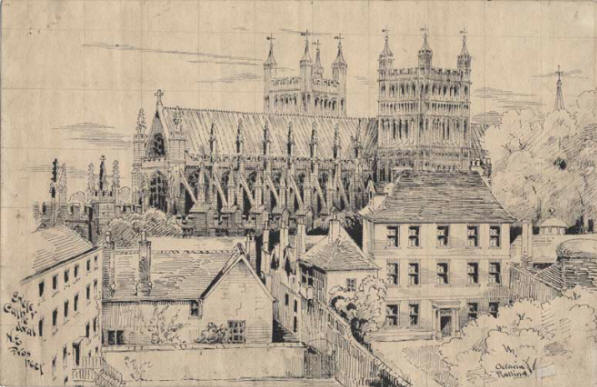 Sketch of Exeter Cathedral Source: Westcountry Studies Library (Devon Library Services) |
|||
In 1892 Ralling and Tonar won a high profile contract in Exeter when they were appointed as architects for the city's Tepid Swimming Baths. There was much made of this project in the local Press, general opinion being that public swimming baths for Exeter were long overdue and that they would be a real asset for the city. The baths were opened in September 1893, with a pool of 75 ft x30ft, 7ft deep end with diving board, 3ft 3ins shallow end, a gallery for 500 spectators, hot and cold douche and slipper baths, 42 changing rooms, meeting rooms, and laundry facilities. They were located centrally, behind the High Street, more or less where the car park of the central library now stands. Despite the publicity that attended the baths' arrival they were never a huge commercial success and never made any money for their shareholders. The City Council acquired them in 1911, and they were destroyed by bombs in the Exeter blitz of May 1942. The architecture of the Tepid Baths was clearly not thought to have affected their commercial success, for in May 1897 the foundation stone was laid for Exeter's Turkish Baths, in Northernhay Street. which were also to be constructed to the designs of Ralling and Tonar. (In Pollards Official Guide to Exeter of 1894, Tonar and Ralling are actually described as "designers of swimming baths". These baths opened in May 1898. The exterior had an "arcaded front" to the first floor; the interior had cooling rooms, plunge baths with douche and spraying equipment, and two hot rooms. On the first floor were private cubicles, and an open piazza surrounded by bays. On the top floor were bedrooms which were to be rented by the Rougemont Hotel which stood alongside the baths - these bedrooms could be accessed directly from the hotel. The interior was decorated with mosaics, and white glazed bricks with blue banding. |
|||
Right: Oddfellows Hall, Exeter, designed by Ralling and Tonar in 1896, with, above, inscribed bronze tablet and foundation stone. |
At about the same time that they were working on plans for the Turkish baths Ralling and Tonar were completing the design of the new Oddfellows Hall, in Catherine Street, Exeter, just a stone's throw from their Bedford Circus offices. They commissioned the builder, Brealy. The foundation stone was laid in June 1896 by Brother P.G. Mansfield, who had been presented with a mallet and silver trowel by Octavius to perform the task. The inaugural meeting was held in the Hall in September 1896. |
||
| A major commission for Ralling and Tonar, and one that was probably dear to Octavius's heart was the restoration of St Nicholas Priory, Exeter. The Benedictine Priory was dedicated in 1087, and the small community of monks there played an active part in city life until the Priory was dissolved by Henry VIII in 1536. Some of the buildings were demolished and a remnant became the home for a wealthy Elizabethan family. It remained a family home until the nineteenth century when it was converted into five dwellings. The building deteriorated over time, and by the early twentieth century what were effectively tenements had become more and more dilapidated. In 1913 the Corporation purchased the building: Ralling and Tonar were given the job of restoration. Octavius had been interested in the building long before getting the contract for the restoration as he had made several sketches of the Priory in the 1890s. The project took from 1913 to 1916. Ralling and Tonar were assisted by Harold Brakspear who was a medieval architectural historian. Octavius maintained a hands-on involvement with the work throughout the restoration. When it was completed the Corporation opened the Priory as a museum. Still a museum, further restoration has been carried out in the 21st Century, and the interior is now furnished and decorated to represent an Elizabethan town house. |
|
||
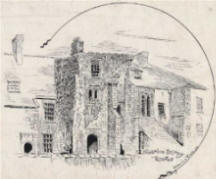 |
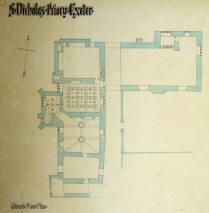 |
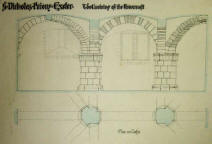 |
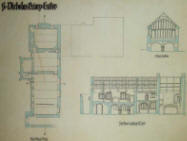 |
| Sketch of St Nicholas Priory by Ralling from 1890s and plans for the 1913-1916 restoration. Source: Westcountry Studies Library (Devon Library Services) | |||
 |
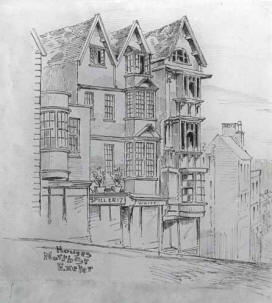 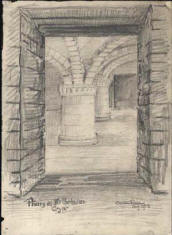 |
||
| Above: A courtyard in Cathedral Close. Source: Westcountry Studies Library (Devon Library Services) | Above left: house in North Street, Exeter and above right: St Nicholas Priory, crypt. Source: Westcountry Studies Library (Devon Library Services) | ||
| It is evident that as well as professional plans and drawings Octavius enjoyed sketching, particularly old buildings, and seized opportunities to indulge his pastime. He certainly sold his sketches for book and magazine illustrations. And in the 1896 Xmas edition of the Exeter Flying Post, Mr. T. Upward of Queen Street was advertising "private Xmas cards, including the new Exeter Card (sketch of the city by Octavius Ralling)" At the following Xmas the same gentleman was advertising cards with " a variety of charming Exeter views sketched by Mr. Octavius Ralling." In 1910 the Exeter Pictorial Record Society was established to collect pictorial representations of the most interesting features of Exeter. The collection contains paintings, prints, drawings, maps as well as photographs. Octavius contributed sketches to this record of the city. |
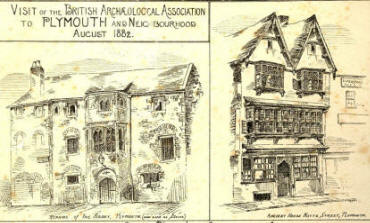 Sketches of Plymouth buildings that Octavius made during a visit to the city by the British Archaeological Association in 1882, perhaps before he had moved to the South West. Source: Plymouth Library Services |
||
| Octavius was also greatly interested in politics. From his early appearance in Exeter in 1884 in the Parliamentary Debating Society, of which he was a leading member, he became an active Conservative - his name often appearing as a seconder or assentor of candidates for national and municipal elections. He was prominent in the affairs of the Working Men's Society, which despite its name was a Conservative group; he was for years the Hon. Secretary of an Exeter branch of the Primrose League - an organisation established to promote Conservative politics; he was vice-president of the St John's Ward Conservative Association. Indeed he may have allowed his political life to stray into his professional life, as in 1890 he was the architect for the new Thorverton and Cadbury Conservative Club building, which was later to become Thorverton Memorial Hall. It may be that Octavius's involvement in politics was owed in part to the social aspects of his activities. When he was still in Colchester in his 20s the newspaper carried reports of his performances in local amateur dramatic performances. Just like his love of sketching, his interest in treading the boards never left him, for the Exeter newspapers reported his participation in plays, sketches and concert parties over the years, some of them organised by Octavius himself, and often in connection with his political activities. On occasions he was joined by his wife, and by his eldest daughter, a singer and pianist, who appeared to share his love of the limelight. In 1893 Mr. and Mrs. Ralling were in a concert party at Ide. The following reports a concert for the Working Men's Society in Exeter in the same year. (Trewman's Exeter Flying post 16 Dec. 1893).
|
Top: Baptismal Well, Mount Edgecombe, Cornwall, and below a view of Exeter from the canal. Source: Westcountry Studies Library (Devon Library Services) |
||
| He was one of the longest standing members of the Devon and Exeter Architectural Society, being for a while its hon. treasurer. He was also a member of the Royal Institute of British Architects. He was a Freemason, but he certainly never reached the illustrious ranks of the order achieved by his brother Thomas. It is evident that despite the family tragedies that blighted his youth, Octavius was able to lead a prosperous, fulfilled and apparently happy life. He was married to Ellen for 38 years. They had six children who survived to adulthood, and the evidence suggests their marriage was a happy one. Three of Octavius's sons left England to work as planters, brokers, merchants and traders in Africa, South America and the Far East, though each of them served in France in the First War. Ellen died in 1926, and Octavius died less than three years later on 1 February 1929. They were buried together in Exeter Higher cemetery. Sadly the grave stone has now been cleared, so there is no marker for Octavius's final resting place. But he left his mark on the architectural heritage of Devon and Cornwall, and thankfully, despite Hitler and later developers, some of that survives still, along with his drawings, as a legacy of his passion for his adopted county, and his talent. |
Watercolour copy of the Grenville coat of arms by |
||
| Thanks to the Westcountry Studies Library, Plymouth Library Services, St Nicholas Priory and Exeter Memories for help with illustrations. | |||

Family on "The Street"
Cheryl Frayling-Wright is the only child of Arthur and Marjorie Frayling-Wright- she
is the granddaughter of PC Arthur Wright, son of Ellen Huxtable. She uses the name Cheryl Murray. At the age of eight years old she joined the famous Elliot Clarke School of Dance and Drama. Then later she enrolled at LAMDA for a three year drama diploma. She has appeared on stage in A String In The Tail,
Separate Tables and Aladdin. On television she had
rôles in Vienna 1900, Games with Love and Death, Microbes and Men,
Dixon of Dock Green, Billy Liar and Crown Court. She played lesbian inmate Julie in
Within These Walls and played Gillian in the police drama Z Cars. In 1991 she was offered her West End Stage debut in
Separate Lives but she was also offered two episodes of Coronation Street. She chose the
Street and joined the cast on 10 January 1977 and continued to play sexy Suzie Birchall until 1981. She returned to the
rôle in 1983 for a year until she finally left in 1984. 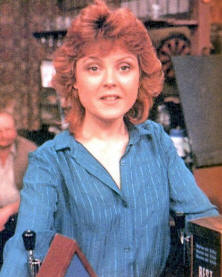
Cheryl Murray as "Suzy Birchall" in the Rovers Return
Cheryl married her first husband, surveyor, Ian Murray in 1970 but they later divorced. She married second husband, management consultant, Colin Jacobs, and their only child Louise was born in 1981. The couple later divorced. Diagnosed with multiple sclerosis, she has now retired from acting.
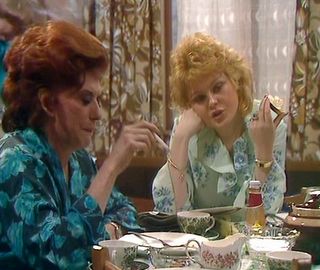
The Feys and the Pymans
Many of the Feys who moved to Bristol, and their in-laws and descendants, were talented musicians and performers, both professionally and as amateurs. Fred Fey was the Musical Director at The People's Palace, Baldwin Street, Bristol - a Music Hall between 1892 and 1912. Fred conducted the orchestra there, and also composed music. His niece Gladys Pyman was featured there at the age of 9. A talented child, she was billed as "The Baby Pianist". She was so tiny her feet could not reach the pedals.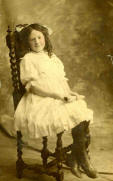 Gladys Pyman
Gladys PymanHer sister Elsie Lillian Pyman played cello with "The Saville Cwyn Orchestra". When she was older Gladys too joined an orchestra - the Bristol Folk House Orchestra. The Bristol Folk House emerged from a movement in 1870 offering education to Bristol dockers and became an established part of the movement for adult education and social action. Part of the national temperance movement in 1922, the name of Bristol Folk House was acquired. Its orchestra would have been established at about that time. Younger sister Queenie Pyman took over as the orchestra's pianist from Gladys who gave up the rôle when she got married. Her brother Gil Pyman was violinist with the orchestra. So too was a former docker William Williams whom Queenie was to marry. And sister Elsie Lillian met her husband through the Saville Cwyn Orchestra. The family seem to have successfully combined romance with their musical talents!
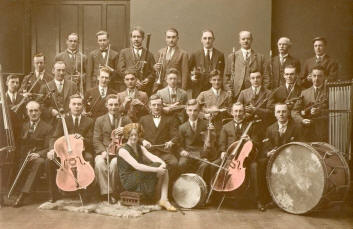
Bristol Folk House Orchestra 1929
William Hector, Pioneer Photographer
William Hector, , the son of a wool sorter and weaver, in the then declining woollen industry of Crediton, followed a different career as a thatcher with his brother, and over 15 years built his business, moving from a modest cottage in an alley, when his wife was employed as a housekeeper, to a much more lavish abode at 40 High Street by 1861, where William was employing two men and a boy, and his wife no longer needed to work. But William was evidently a man of ingenuity and enthusiasm. Somewhere along the way he developed an interest in science, which he pursued through astronomy, and the newly invented skill of photography. Initially William's interest was as a gifted amateur. Photography as anything more than just a scientific experiment had been around for less than 15 years when he began to experiment with it, and by 1861 he had submitted a small photograph to the exhibition of the Photographic Society of Scotland. In 1860 William risked life and limb for some photo journalism when he secreted himself in some bushes to take photos of the hovel where the North Devon Savages lived.
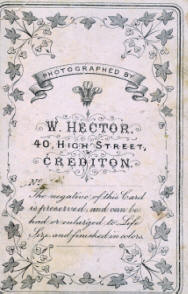
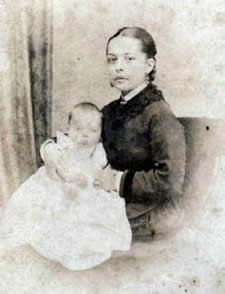
The reverse of Hector's Carte de Visite, and his carte of my great grandmother Mary Wright and grandmother Kate

By the mid 1860s the local press were describing William as "our skilful townsman" and his work as "excellent specimens of the photographic art". On 1st October 1869 there was a review of William's business in Photographic News. In the 1871 census William at his High Street premises described himself as Thatcher and Photographer
This would have been one of William's earliest photographs, of the building of the railway from Crediton, in 1852
His son John was living a few doors away carrying on his business as
Painter and Glazier. His son William was living with his parents, his
occupation Organist. (Their neighbour was carpenter William Fey) By the
early 1870s the business was well established. By 1878 not only did he have
the Crediton business, but had opened at Fore Street, Okehampton. By 1881
William had given up thatching, and described himself in the census as a
Photographer. His daughter Amelia was his Assistant, still at 40 High Street.
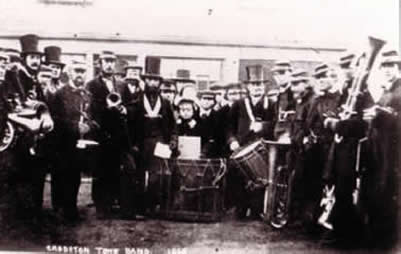
There is some doubt about this picture of Crediton Town band above. Some opinion has it that the gentleman with the side drum is William and other, that the person to the right of the drummer is William's brother Thomas. Perhaps both are true. We are sure the photo was from William's studio.
There is a family story that William collaborated with William Friese-Greene, a pioneer in moving pictures, but whilst they may have known one another as photographers, Friese-Greene did not experiment with movies until after William's death. Perhaps the collaborator was his son-in-law Henry Cornish, for after William's death the business at 40 High Street Crediton was taken over by Cornish, who had married William's daughter and photographic assistant Amelia.
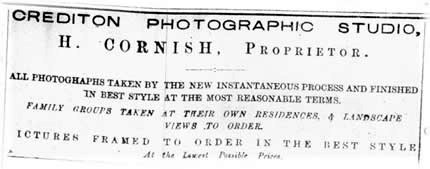
Newspaper adverts for William Hector photographer, and Henry Cornish, son-in-law and William's successor in the studio
The Hectors certainly had artistic genes, for son William (1852 - 1925), seen below on the left standing in the doorway of his shop, was not only a watchmaker and jeweller, but developed his skills as an organist and music teacher. Young William had been the organist at Shobrooke Parish Church by the age of 12. He was organist at the Unitarian Chapel in Crediton when 15. (He went on strike there in support of his request for payment for his time). Local newspapers carried many reports of William's public performances, with praise not only for his accomplishment as a musician, but also as a teacher, and the proficiency of his pupils. He became organist at Newton St Cyres parish church, where he served for over 50 years.
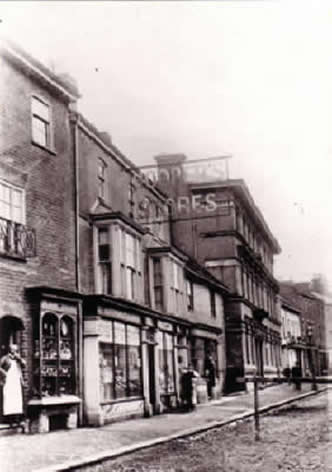
As jeweller William Jnr had contributed a trophy for
best shots in the Crediton Rifle Volunteers in the 1880s.
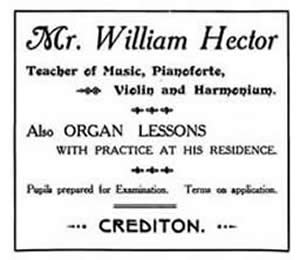
Ralph Rillman Miller
In the 1940 US census Ralph Miller (married to Margaret Donald, great granddaughter of Elizabeth Berry) recorded his occupation as singer. He was a high tenor and could hit a high 'G'. He sang at the Metropolitan Opera for a year or so in the men’s chorus . Ralph was a talented man. He went on to work for some time as an aircraft engineer, but returned to the Arts when in 1951 he was appointed Assistant Director of the Museum of the City of New York. But he was a self-taught artist and was also exhibiting his own work. He was interested particularly in researching and experimenting with the technology of the Renaissance Masters, making his own paints and varnishes. He divorced Margaret and in 1962 married his secretary Helen Marcy. In 1960 he was appointed Director of the Museum and stayed in the post until 1970, but he took early retirement then to pursue a career as portrait painter and artist. He met his third wife, Neilah Price, whilst learning Renaissance pigment-making techniques in Florence, and went to live with her in South Africa, where he died in 1994.
Country Afternoon. Oil on canvas by Ralph Miller,
1957
Phillip Boydell - Artist and Art Director
Phillip Boydell was born on 21 May 1896 in a working class terraced two-up-two-down in Tyldesley Lancashire, to Oliver Boydell (a master decorator) and Merinda.
He obtained a scholarship at the Manchester School of Art and after three years, nearing the end of his studies there, he was awarded a scholarship to the Royal College of Art just after the outbreak of World War I. He joined the RNVR to be a wireless telegraphist, which put a temporary stop to his education. He served mainly in the tug Black Cock, which sank in winter off Murmansk, but Boydell lived to tell the tale. Demobbed in 1919 he was able to continue his education at the Royal College of Art. His intention was to design ecclesiastical stained glass. But as a Design student he took on some commercial contracts including architectural design for a cinema and a shop window display for Austin Reed, so it was unsurprising that he drifted away from stained glass towards graphic design.
La Terrasse à St Tropez by Boydell c. 1951
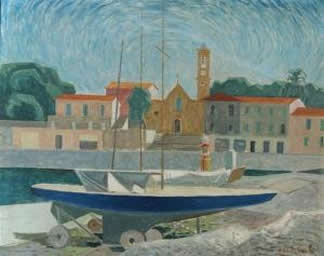
St Jean, Cap Ferrat by Boydell
He stayed with the London Press Exchange for the rest of his life. In World War II the agency collaborated with its former competitors on government advertising and propaganda. It was during this period that Phillip created an image that was to be famous around the world. There was concern at the way the public were wasting money when it was in the nation's interests that they invested in savings bonds. Whilst off work with the flu Boydell conceived the idea of the Squander Bug (originally the Money Bug)- a nasty creature who encouraged wasteful expenditure. It was to feature on posters and in cartoons and in newspapers both in the UK, and then later in the USA, and in Australia in adapted versions.
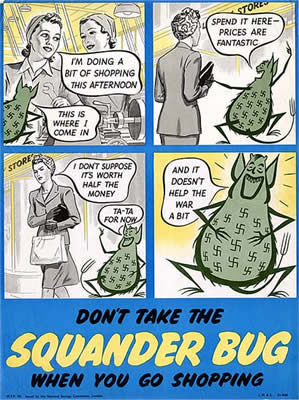
The Squanderbug

The "Black Widow" poster designed by Boydell
In 1950 he designed the typeface that was to be the official display type for The Festival of Britain in 1951. Festival Titling was used in all the communications for the festival. It was cut by Monotype in 1950 and was made available for general use in 1952.
Festival Titling designed by Boydell in 1950, and its
application on a Festival of Britain poster
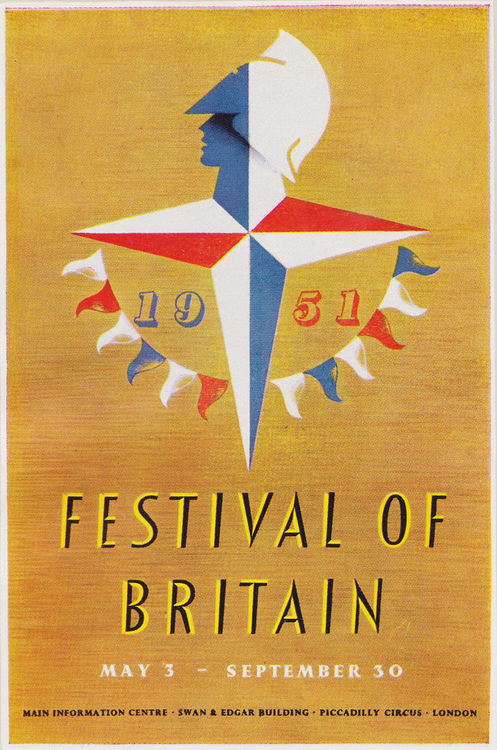
In 1951 he was elected President of the Advertising Creative Circle. His work for the London Press Exchange took him to South Africa and the USA. But he and Bill loved above all other travel their visits to France and from 1947 on they had managed to visit the country for touring holidays twice every year. Whilst there he painted many landscapes. On his first trip after the war he painted the landscape of Rouen outside his hotel. It was exhibited at the Royal Academy and purchased by the JCR of Trinity College, Oxford.
Rouen after the rain by Boydell 1947
In 1961 Phillip joined the Board of Directors of the London Press Exchange's parent company. He retired shortly after.
His wife Bill suffered a long and incapacitating illness, and died in 1977. Phillip Boydell died at home in Putney in 1984.
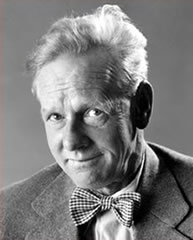
Some More Family Artists and Performers
Ray Heard 1948-2010 Singer and musician, played in a band performing traditional and modern folk. Sadly missed cousin.
William Wallace Andrew 1891-1939 William sang in the Glasgow cathedral choir, and also played the organ there. His wife Agnes sang contralto in the choir. Great grandson of poet George Donald (senior).
Gavin McLean Andrew 18796-1978. Brother of William Wallace above, Gavin was described as a musician. He died in Vancouver.
Minnie Alby née Mitchell 1868-1918 was an artist by profession, best known for her landscapes. Granddaughter of William Hector, she lived in Wisconsin USA
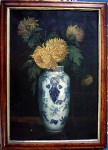
Minnie Alby painting
Victor Jack Stone 1895-1961 was for some years the lead violinist with the orchestra of the Toowoomba Philharmonic Society, Queensland, Australia.
John Fey 1822-1877 was a carver and guilder, who was born in Spreyton, then moved to Exeter. By 1871 he was working as a photographer at 249/250 High Street. It has not been possible to discover much about his photographic work - a craftsman or an artist? Certainly he was listed as a photographer carrying on his own business in White's 1878 Trades Directory.
Lewis Wills 1868-1942 sang in the Wandsworth Male Voice Choir, and the choir of Grafton Street Congregational Church
Francis Bellringer A.R.C.M. 1896-1974 was an organist and conductor in Derbyshire at Trent College.
William Edwards 1881-? was a painter from Lancashire. Our family still have some of his portraits.
William Cann 1832-1886. William lived his life in Exeter, the nephew of wrestler Abe Cann. He was described as a musician. We know no more about him.
Frank Ralph Conibear 1896-1988. Frank was a trapper in the North West Territories of Canada. As well as designing a humane trap that bears his name, he was also an author. He began writing pamphlets and books based on his keen observations of forest animals. Devil Dog was modelled after one of his lead dogs. His best-known book is The Wise One, a story about the adventurous life of a black beaver, co-authored with J.L. Blundell and published in 1949. He sold the rights of one book he wrote to Walt Disney.
 Frank Conibear
Frank Conibear
William Coverly Mitchell 1834-1908. William married Jane Hector, daughter of William, the photographer. He too was a successful photographer. He also described himself as an artist in his early life.
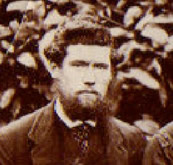 William Mitchell
William Mitchell
Rosetta Bland 1825-1875. Wife of Thomas Ralling was a music teacher, and gave performances on the piano.
Anna Airy 1882-1964 was a very distant cousin to our Helmores, and possibly to our Linscotts too. She was an oil painter, pastel artist and etcher, working in Britain. She was born in Greenwich, London, daughter of engineer Wilfrid Airy and Anna née Listing, and granddaughter of Astronomer Royal Sir George Biddell Airy. She attended the Slade School of Fine Art in London, where she was taught by Henry Tonks and Philip Wilson Steer. She was one of the first women officially commissioned as a war artist. In June 1918 the Munitions Committee of the Imperial War Museum commissioned four paintings by Airy representing typical scenes in four munitions factories. These include A Shell Forge at a National Projectile Factory, Hackney Marshes, London (below), featured in the Museum's 2011-2012 exhibition Women War Artists.

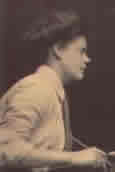
Anna Airy
Joseph Pollard 1827-1903, of the
clock-making family learned his musicianship in Crediton, but
in 1859 went to Australia and at Bendigo, Victoria, Australia, he made his
mark as a "professor of music", conductor and musician. By 1871 he had
returned to England and was living in Ramsgate, Kent, where he was organist at St George's
Church. He was a composer known for his instrumental pieces for piano and
organ, for songs, canzonettas, duets and
hymns. His works were sung by Victorian singers of note including Henry Guy and
Willoughby Weiss, and in 1882 Queen Victoria happily accepted his dedication of a
Reverie for piano. He was an Associate of the Royal Academy of Music,
and his Blind Girl , with full orchestral accompaniments, was sung
at a Royal Academy Concert, and was favourably received by the critics.
Other compositions for the organ include Marche des Vainqueurs (1874)
and Right and Victory - a Patriotic March from 1902.
|
|
| Bendigo Advertiser May 1860 |
Tom Cobley
Rather than a creator, here is the subject of creativity - perhaps. The traditional Devonshire song, Widecombe Fair, collected by Sabine-Gould, tells of the doomed journey of Old Uncle Tom Cobley and his friends to Widecombe Fair. Many believe that the original Tom Cobley died in Spreyton, in 1794. My research has identified a Spreyton Tom Cobley of this date of death who was married to a Mary Heard, not a direct ancestor of ours: but that Tom was an ancestor of one of our Linscott family and like them had connections with Colebrooke.
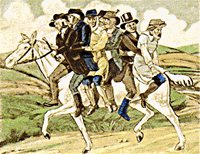
|
|
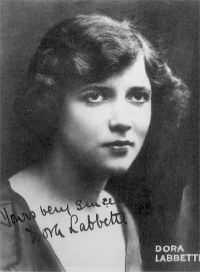 |
|

Captain David Strang, by his father |
Dora Labbette (4 March 1898 –
3 September 1984) was an English soprano. Her career
spanned the concert hall and the opera house. At the
peak of her career in the concert halls, she conspired
with Sir Thomas Beecham to appear at the Royal Opera House
masquerading as an Italian singer by the name of Lisa
Perli. In her private life she had an affair with Beecham,
with whom she had a son. Dora was born Dorothy Bella Labbett in Woodside, near Croydon, rather than in nearby Purley, as she was later famously to claim. The Labbetts are a Crediton family; in 1865 John Labbett married my great-great-aunt Maria Fey, and moved to Devonport where he became a police constable in the Dockyard. From 1861 the Royal Dockyards were policed by the Metropolitan Police. Dora's father John was born to PC Labbett and g-great aunt Maria in Devonport. Constable John Labbett senior and his family moved to Paddington in 1872 where he served in D Division, or Marylebone. Dora's mother was Nellie Berry, the daughter of a Crediton cordwainer. In 1891 both these Devon families, the Berrys and Labbetts, had ended up living in the same apartment building in Paddington. Four years later John Labbett and Nellie Berry were married. John worked at a variety of jobs. He was a carpenter, licensed railway porter, and later a railway clerk. He suffered from poor health, and after Dorothy's birth he moved the family from Croydon to Hastings, in the hope that the sea air would be good for him. The move appears to be in vain, for he died in 1903. Spotted singing at concerts when 10, in Hastings, Dora's prodigious talent was developed by generous support from composer Florence Aylward, opera star Liz Lehmann and renowned organist and chorus master Dr Herman Brearley. She tried for and gained a scholarship to attend Guildhall School of Music, where she became one of their most famous students. Named gold medalist in 1916, she was recipient in 1917 of the Landon Ronald prize...as "likely to become the best artist of all the students that year." Whilst there she sang in front of Queen Alexandra in 1917. She also studied with Liza Lehmann, who took her to sing to the music publisher and impresario William Boosey, who gave her a contract to sing songs published by his company, at "Ballad concerts, Promenades and Sunday evening concerts". She made her Wigmore Hall début in 1917, and soon found herself in demand as an English soprano, for oratorios and ballad concerts, giving her a lucrative career. She had met a dashing Captain in the Royal Engineers, David Rogerson Strang, and on 15 April 1918, seven months before the Armistice, they were married in the Parish Church of St. Mark, Hamilton Terrace in London. She was twenty, the soldier thirty. His father was William Strang, a famous artist of the previous century. The son had inherited his father's artistic temperament. They lived at 70 Carlton Hill, St. John's Wood, a smart London suburb, where on 18 April 1919, their daughter Joan was born. Strang wanted Dora to give up her singing career, but she resisted, and nineteen months later, she walked out of marital life, pulling a handcart heaped high with her belongings. Dora and infant Joan took lodging at 3, Pembridge Place, Notting Hill, another desirable suburb. In 1922 she began a series of duet recordings with tenor Hubert Eisdell for Columbia Records. She became a regular performer on Henry Wood’s ever popular promenade concerts, appearing on many occasions. As well as the Proms, she sang in concerts with orchestras throughout the UK. Late in 1925, she performed twice in Hull - the second time on 17 December in Handel's Messiah with the Vocal Society. After this Beecham asked her to participate in a recording of the Messiah. This was the start of her relationship with the conductor. At Christmas 1928 she appeared in Beecham's "magnificent" production of the oratorio at The Queen's Hall, with the London Symphony Orchestra and the Philharmonic Choir. In the following year Beecham presented Dora to the King and Queen at The Queen's Hall, in a revival of Handel's Solomon. Beecham took her to France where she sang for the ailing composer Delius. She was the soprano soloist at the first performance of Delius's Idyll in 1933. By this time she had gained considerable fame and popularity, as a "BBC artiste", a recording artist and a concert and oratorio performer. Dora's marriage to Strang had been annulled in 1928. Beecham began proposing marriage, offering to part officially from his wife Utica in America. Dora however wanted him to seek a divorce in London, although she acknowledged that Utica would very likely oppose it. It was a stalemate. Nonetheless their relationship had continued and in 1933 Dora gave birth to their son Paul. Beecham insisted on making legal arrangements for maintenance of his son when Dora stopped working, and would later pay for Paul's schooling. Dora Labbette was established so firmly in the world of oratorio and the concert hall, but she was ambitious to create the full rôles of heroines in opera. A few arias sung in concert simply whetted her appetite to sing a complete opera. "As for the Messiah, the Creation and Elijah, I must have sung the leading soprano parts in these oratorios hundreds of times, until I felt I would shriek if I were asked to do them again.... But it seemed quite hopeless and against all tradition that a singer who had been identified with the concert platform should desire to appear on the operatic stage." Who would take her seriously? She made a first move in Oxford in 1934, when the University Opera Club invited her to appear as Telaire in Rameau's Castor et Pollux. Then in March 1935 for the London and Provincial Opera Society, with Barbirolli conducting, she took the rôle of Juliet in Gounod's Romeo and Juliet with Heddle Nash. |
|
"Lisa Perli", or Dora Labbette as Juliette |
|
|
Dora Labbette portrait by Walter Strang |
Dora with Beecham, en route to New York, Christmas 1935 |
|
Dora as Mimi in La Bohème with Heddle Nash at Covent Garden |
These beginnings inspired Dora further, and in 1935
a mysterious bewigged and veiled blonde stranger turned up
at the Royal Opera House, Covent Garden, to audition for
the rôle of Mimi in an upcoming series of La Bohème performances.
It was no contest. The stranger impressed all, and was
immediately signed for the rôle. Engaged as Signorina
"Lisa Perli" (Dora had adopted her Surrey birth area as a
surname) still heavily veiled, she came to a rehearsal,
and finally a member of the chorus recognised her as Dora.
Beecham was in on the ruse, and demanded that she be
called, "Signorina Perli, if you don't mind" The press and public were not long deceived by the pseudonym, and she was rapidly accepted as an opera singer. She was a triumph in the role. The critic Neville Cardus wrote of her, "Lisa Perli is the best of our Mimis. She has a genius for diminutive pathos and in the closing scene she can bring moistness to the throat of the hardened critic." She toured it throughout opera houses of England and Europe in subsequent years, winning great acclaim wherever it was performed. At the end of 1935, Beecham sailed to America for a third series of concerts with the New York Philharmonic Orchestra, beginning on 2 January 1936. Dora accompanied him . On their return, during a visit to the Theatre Royal in Glasgow in March 1936, ‘Lisa’ sang in Romeo and Juliet as Beecham conducted. After this operatic success, she went to Paris and studied Debussy's Pelléas and Mélisande, subsequently singing Mélisande at Vichy and Bordeaux and at Covent Garden the following summer. Her other operatic rôles in 1935-1938 included Desdemona in Otello, Juliette in Roméo et Juliette, Marguerite in Faust, and the title rôle in Mignon. She toured with the English Opera Company, and also performed in Munich, Dresden and Berlin. In 1938 Dora recorded a selection of Delius's songs at Abbey Road : "Whither," "I Brasil," "The Violet," "Sweet Venevil" and "Twilight Fancies" with Beecham leading the London Philharmonic Orchestra. During the summer of 1940 Beecham sailed off to Australia with his lady, the exotic "Lisa Perli" on his arm. "Lisa" made seven appearances on the tour, which took in Melbourne, Brisbane, Sydney, Adelaide and Perth. This was an unhappy time for Dora, with Beecham making unpleasant comments about Dora at every opportunity, sure signs that his relationship with her was nearing its end. Among her last concert performances was in The Creation, with Beecham, in Sydney in 1940. They returned to England via Canada, travelling by train from Vancouver to Montreal, where at the beginning of November 1940, Dora boarded ship for Britain. This was a dangerous time to cross the Atlantic with the risk U-boat attacks. She was anxious to return to her children in London. Beecham had meant to follow after completing engagements in Canada and the United States. However he was offered a conductorship with the New York Metropolitan Opera so he remained in the USA. Dora bade farewell to him in Canada, and he was never to rejoin her. When Beecham gave a concert in Vancouver on 7 November 1941, Miss Betty Humby played Mozart's Piano Concerto No. 24; it was she who would become the next Lady Beecham. Once back in wartime Britain, Dora resumed her career with a series of broadcasts for the BBC that included operatic arias with Boult and the BBC Orchestra. She also worked for the Motor Transport Corps, delivering medical supplies to hospitals and helped to raise money to equip the London Philharmonic Mobile canteen, which she drove to the scene of air-raids to provide refreshments to the emergency services and blitz victims. Although she continued to perform, it appeared that her heart was not in it, and the news of Beecham’s marriage to Betty Humby on 18 January, 1943 shattered her. She took part in a production in English of André Messager’s operetta Monsieur Beaucaire during a provincial tour in 1943. It was well reviewed but box office receipts hardly merited risking a London showing. That year she made her final appearance in opera, appropriately enough as Mimi, with Sadlers Wells Opera. Abandoned by the love of her life, Dora had lost interest in performing. She moved to Sidlesham, on the Manhood Peninsula in West Sussex, and gave up her life to gardening, keeping chickens and breeding spaniels. In her later years one could sense her love for Beecham never left her. Lung cancer having spread throughout her body, Dora suffered a stroke and died on 3 September 1984, aged 86, in Selsey, near Chichester. The New Grove Dictionary of Opera said of her: "Her voice was true, pure and youthful, and she was an outstanding actress." |
|
Dora at the end of her career, in Monsieur Beaucaire, in Glasgow, in May 1943 |
|
Our Cousin Gave Us Babe!
 Ronald Gordon King-Smith was the great grandson of our grand old man of
Newport, William Esau Heard. William's third daughter married Welsh Rugby
International Arthur Boucher: their daughter Grace left Wales to marry into
the King-Smiths, a paper-making family in Bitton, Gloucestershire, where they
produced fine quality writing paper. Grace and Ronald King-Smith's son
was also named
Ronald, but was known as Dick; he had a very varied career of quite distinct
parts. He was educated at Marlborough College, and then having always
been attracted to farming, he found work as a farm apprentice in Wiltshire, paid £1 per week. But World War II broke out and Dick joined the
Grenadier Guards. The young officer became a platoon commander and was in
action at the Salerno Landings in Italy, and with his platoon fought his way
up through Italy, until he was severely wounded by a grenade in 1944. It took
him some time to recover, but he eventually found his way back into farming.
He loved the life, but he had no business head, so struggled to make enough
from farming
to support himself, his wife and three children. Dick and his wife both loved
working with animals, and all sorts of beasts became part of their life on the
farm -cows, pigs, goats, hens, ducks, geese, pheasants, budgerigars, tortoises,
mice, rabbits and guinea-pigs, not to mention a variety of cats and dogs. Each
was given a name and treated more like a pet than a working animal. But
this was no way to make a profit at farming. Dick freely admitted, "although I’m
good with words, I’m no good with numbers. If you’re no good at numbers you
are no good at business and if you’re no good at business you are no good at
farming."
Ronald Gordon King-Smith was the great grandson of our grand old man of
Newport, William Esau Heard. William's third daughter married Welsh Rugby
International Arthur Boucher: their daughter Grace left Wales to marry into
the King-Smiths, a paper-making family in Bitton, Gloucestershire, where they
produced fine quality writing paper. Grace and Ronald King-Smith's son
was also named
Ronald, but was known as Dick; he had a very varied career of quite distinct
parts. He was educated at Marlborough College, and then having always
been attracted to farming, he found work as a farm apprentice in Wiltshire, paid £1 per week. But World War II broke out and Dick joined the
Grenadier Guards. The young officer became a platoon commander and was in
action at the Salerno Landings in Italy, and with his platoon fought his way
up through Italy, until he was severely wounded by a grenade in 1944. It took
him some time to recover, but he eventually found his way back into farming.
He loved the life, but he had no business head, so struggled to make enough
from farming
to support himself, his wife and three children. Dick and his wife both loved
working with animals, and all sorts of beasts became part of their life on the
farm -cows, pigs, goats, hens, ducks, geese, pheasants, budgerigars, tortoises,
mice, rabbits and guinea-pigs, not to mention a variety of cats and dogs. Each
was given a name and treated more like a pet than a working animal. But
this was no way to make a profit at farming. Dick freely admitted, "although I’m
good with words, I’m no good with numbers. If you’re no good at numbers you
are no good at business and if you’re no good at business you are no good at
farming."

The King-Smith family paper mill at Bitton, Gloucestershire
The family paper-mill came to his rescue, when the business bought a farm to provide the provisions for the mill's canteen, and appointed Dick the farmer. But he never made a profit and the farm had to close when the mill stopped trading in 1961. A friend offered him the tenancy of a nearby farm, and he tried to run it profitably for 6 years, but in vain. Dick had farmed happily but unsuccessfully for 20 years. He needed a new direction. For a while he had experimented with writing, and had some modest success, with poems and articles accepted for publication. But he did not persevere, instead trying one or two other jobs, with little enthusiasm. Then when daughter Juliet decided to start a teacher training course, Dick saw potential for a new career direction, and enrolled at St Matthias College in Bristol, achieving a Bachelor of Education degree at the same time as his daughter and son. He found a job teaching 8 year-olds at Farmborough Primary School, near the family home.
His weakness at long division meant that after a few years he was shifted from teaching 8 year-olds to concentrate on infant classes. He was a natural storyteller and could not have been better suited to his young pupils' needs. In the school holidays of 1976 he tried writing again. It took him three weeks to complete his first draft of The Fox Busters, about chickens that turned the tables on foxes who were out to kill them. He submitted his typescripts to one or two publishers, and after dogged perseverance Dick had The Fox Busters accepted for publication by Victor Gollancz in 1978. It was an immediate success, and seemed to open the floodgates of Dick's creative imagination. Further books were published in 1980, 1981 1982, and in that year he was able to give up teaching and concentrate on his writing.


Cover of The Sheep-Pig on which the film Babe was based, and the film poster.
In 1983 he published his most popular and famous book, The Sheep-Pig. This was adapted as the movie Babe in 1995, winning 20 awards, including one Oscar, one Golden Globe and one British Comedy Award. It was not the only adaptation of Dick's books into film or TV programmes, unsurprising, given the popularity of his works with children. Other adaptations include Harry's Mad, The Foxbusters, The Water Horse, The Queen's Nose. In the 1980s and 1990s Dick himself appeared on TV, presenting children's programmes, including Pob's Programme, Rub-A-Dub-Tub and Tumbledown Farm.

Dick with on-screen 'granddaughter'
Georgina, in Tumbledown Farm.
But he didn't give up his writing. Dick was to have some 130 titles published, including not only children's books, but also books for young adults and for adults, and a play. He sold over 150 million books worldwide. He won the 1984 Guardian Children's Fiction Prize, Children's Author of the Year in the 1991 British Book Awards, and the Children's Book Award in 1995. He was awarded an Honorary Master of Education degree, by the University of the West of England, and an Honorary Doctorate by the University of Gloucester. In 2010 He was appointed Officer of the Order of the British Empire in the New Year's Honours List, for services to children's literature. Dick died in January 2011.

Film and TV Artist [Basil] John Pett
Basil John Pett, son of George Pett and Hilda Larkworthy, and brother-in-law to cousin Jack Wright, was born in 1927, to a family that had farmed in Shebbear for four generations. His father George suffered from the legacy of shell-shock and the effects of poison gas from World War I. The family struggled with poverty in the 20s and 30s, a time that was tough for many. It was only in 1937, when George and Hilda moved to Cheriton Bishop, some 30 miles from Shebbear, and there ran the village sub-post office together, that life improved for the family.
Basil had won first prize in a baby show in 1928, with a silver spoon as prize - maybe an omen, as he continued to do well winning other prizes in village entertainments. Mother Hilda acted and sang in local village shows. In 1937 she performed in a scene from Twelfth Night for the Cheriton Bishop Women’s Institute. Basil was to follow this lead. At times with his brother and sister, and at times by himself, we find young Basil giving recitations to the Women’s Institute and to the Methodist Sunday School. In the Western Times review of the Cheriton Bishop Nativity Mime for Christmas 1942, Mr. Basil Pett’s performance as the High Priest was praised as “magnificent and commanding”.
Later he attended London Technical schools which had
been evacuated to Devon - Borough Polytechnic, in Exeter, then Beaufoy
Technical Institute in Budleigh Salterton. He went on to study at the
University College of South West in Exeter. He failed his first-year civil
engineering exams, but he had decided after performing in plays at college
that he would seek out a career in the theatre. Although the War was over, he
first had to serve his time in the Army. From 1945 to 1948 he served
in the Intelligence Corps and the Education Corps. He then became
an actor and assistant stage manager at Salisbury Theatre. He studied
for a year at the Old Vic school in London, and followed this with a season
touring with the West of England theatre company, followed by more time
in rep. He managed to get parts in some BBC radio plays, and in 1955 he
appeared in a bit part, uncredited, as a wireless operator, in the Basil Dearden Ealing film Out of the Clouds. He married his first wife Greta in 1955 and they
had two children. They were later divorced.
Obliged to spend a brief period away from the
boards, as a reporter and drama and film critic on the Croydon Advertiser,
Basil’s fortunes changed in 1961, when Independent Television launched its
west country channel in Plymouth - Westward Television. With his recent
experience Basil was ideal to present its film programme, Stars in the
West. From there he became a continuity announcer with Westward, and a
news reader. It was at this point in his career that the wider family became
aware of his role in TV and film, including me.
Westward TV gave him an opening into
documentary-making for the region, and for the network; then for the BBC
and, later, Channel 4. He made a linked series – One Percent of Us
- So Many Children (1966), about a group born with disabilities, focused
on Downham School in Plymouth. (He followed up some of them over the next 20
years in One Percent of Us - Children No More (1976) and One
Percent of Us - One in a Hundred (1986) to see how they were coping with
adolescence and adulthood.) He presented The Price of a Record
(1967), about Donald Campbell and his ambitious pursuit of speed records
that proved fatal. He continued making a number of one-off single
documentaries such as The Privileged (1968), about the
expansion of universities, which he wrote and produced, and The Silent
Valley (1971), about the demise of tin-mining in Cornwall (a silver
medal winner at the New York international film and television festival).
He directed an Omnibus documentary on the
cartoonist Ronald Searle (1975). He made Moonlight Sonata (1980), on
the German bombing of Coventry. Close to his heart, in 1983, he made a
Channel 4 drama-documentary, Going Home: Shebbear. The
semi-autobiographical account of his growing up in Devon in the 1930s, when
his parents struggled with poverty, was filmed on location in the village.
His daughter was in the film, as were many of the villagers, as extras.
Further documentaries included The Story of English (1986), charting
how Shakespeare’s language was taken to the New World, and in 1987 he wrote
and directed Inheritance for Central Television about a child growing
up to inherit a farm in a countryside where schools were under threat of
closure, and transport links poor. In 1990 he directed an episode of the
multinational 8 episode documentary The Blue Revolution about the
relationship between people and the sea, for the Australian Broadcasting
Corporation. He continued making programmes for the south west
independent channel, TSW, including Heart and Sole in 1985 about the
link between sedentary life and blood clots. Golden Hours and Sad
Partings in 1985 was a Channel 4 Documentary about the Normandy town of
Villers-sur-Mer and its raison d'être, the seaside holiday. Stranger In A
Strange Land (1990) featured Jewish writer Karen Gershon, who came to
England with the Kindertransport in 1938.
Basil’s documentary followed her on a first visit to the city of her birth
in Germany. In 1993 Basil produced an Assignment programme, Secrets of
the General, about the repressive Paraguayan
dictator Stroessner.
In the early 1970s he learned that Jeremy Isaacs
was planning a major documentary series about World War Two – The World
at War. Basil was very keen to be involved in the project. Isaacs appointed Basil to produce and direct the episode about
the Burma campaign. The episode, It’s a
Lovely Day Tomorrow, was one of three that Pett directed. He managed to
convey the pressures of the jungle on Britain’s “forgotten army” in
the one hour episode. A British army sergeant recalled it as “really scary”
while a Japanese officer described it as “a friendly place, dark, where you
could cover yourself and camouflage yourself”. A critic noted that
“Pett included similar firsthand insights in Morning, the episode
about D-Day – the long preparations, then “hours of death, fear, courage, of
plans gone wrong, of rapid improvisation” – and Pacific, on the
Americans driving back the Japanese from Tarawa, Iwo Jima and Okinawa.” His
work on the three episodes of The World at War was some of his best.
In 1984 when they were living in Harrow, North
London, he married his partner Victoria. They had two children.
In addition to the many TV shows for which he
gave commentaries or presented, he was credited as producer and/or director
of over 40 documentaries. He received two Emmy awards for outstanding
documentary work, as well as many festival awards.
In his later years he was Professor of Film and
Television Technologies in the School of Media and Film at the University of
Winchester, and he also taught at the Northern Media School, Sheffield. At
Winchester he developed an International Student Co-Production project
linking the Winchester School with the International Film School of Paris,
and the St. Petersburg University for Film and Television, promoting
cross-cultural creativity. He retired from teaching at the age of 85.
As he aged, his mobility deteriorated and he suffered a number of falls, stays in hospital and care homes. Sadly his frailty continued with more falls. After his last fall he received palliative care in hospital for two weeks and died in his sleep on 30 November 2021, aged 94.
